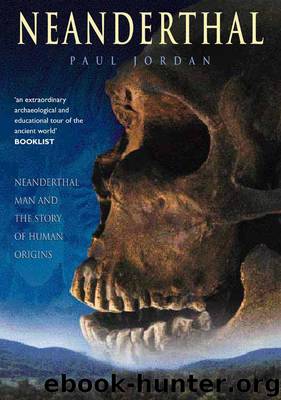Neanderthal: Neanderthal Man and the Story of Human Origins by Jordan Paul

Author:Jordan, Paul [Jordan, Paul]
Language: eng
Format: azw3
ISBN: 9780752494807
Publisher: The History Press
Published: 2001-01-31T16:00:00+00:00
Possibly non-utilitarian markings on pieces from Mousterian sites: Abri Souard above, Quneitra below.
Among the remaining candidates for artistic status among the products found on Mousterian sites are: a circular sandstone pebble from Axlor in the Basque Country with a central groove and two cupule hollows; some grooved bear teeth from Belgium; lined bone fragments from Molodova in the Ukraine; a number of perforated bones, a horse canine with parallel lines and a saiga antelope phalange with a fan of lines from the Crimea; pebbles and flakes of flint from RiparoTagliente in Italy with engraved lines, including a double arc; a similar piece from Quneitra in Israel with straight lines and concentric semicircles; and a nummulite fossil from Tata in Hungary on which a natural crack has been augmented with a straight incision at right angles to form a cross. Even if we allow for neglect by archaeologists who have not expected to find any sort of art in Mousterian contexts and have not looked hard for it, and if we credit the available evidence beyond its deserts, all this constitutes a meagre haul of potentially symbolic creation on the part of the Neanderthalers – a situation that has a bearing on discussion of Neanderthal mental capacities.
It has been said of the Neanderthalers in the light of what they left behind them (and what they did not leave) that it looks as though they lived every day like the first day of their lives, with everything on a short-term basis. Their own bones are thick from heavy labour, as if they lacked the wit to make life easy on themselves; their home sites show a low level of organization; their tools are limited in range of types and found without much cultural variation over huge areas like those of their predecessors (and quite unlike those of their successors); they got their food, like their raw materials, opportunistically and stored none of it against a snowy day; they buried their dead on occasions, but without the clear ritual element of later people; they followed no religion that we can see except perhaps for some awe of bears; they produced, to all intents and purposes, no art whatsoever and wore no personal decoration (unless it was colouring of clothes and skin) to mark any complexity in their social relations; a cloud hangs over the very humanity, as we apprehend it, of their sexual and family arrangements. Despite their large brains, they were in some respects more like all their primitive forebears and indeed the ape-like ancestors of the human line than they were like us. But then, the same could be said of the early modern representatives of Homo sapiens that were their contemporaries in Africa and the Levant. They were even more like us than the Neanderthalers were in skull shape and postcranial physique, but they made the same Mousterian tools and left nothing behind them for a long time to prefigure the achievement of their Upper Palaeolithic descendants and ourselves. In
Download
This site does not store any files on its server. We only index and link to content provided by other sites. Please contact the content providers to delete copyright contents if any and email us, we'll remove relevant links or contents immediately.
The Daily Stoic by Holiday Ryan & Hanselman Stephen(3191)
The Fate of Rome: Climate, Disease, and the End of an Empire (The Princeton History of the Ancient World) by Kyle Harper(2971)
People of the Earth: An Introduction to World Prehistory by Dr. Brian Fagan & Nadia Durrani(2670)
Ancient Worlds by Michael Scott(2573)
Babylon's Ark by Lawrence Anthony(2485)
The Daily Stoic by Ryan Holiday & Stephen Hanselman(2420)
Foreign Devils on the Silk Road: The Search for the Lost Treasures of Central Asia by Peter Hopkirk(2403)
India's Ancient Past by R.S. Sharma(2363)
MOSES THE EGYPTIAN by Jan Assmann(2340)
The Complete Dead Sea Scrolls in English (7th Edition) (Penguin Classics) by Geza Vermes(2198)
Lost Technologies of Ancient Egypt by Christopher Dunn(2168)
The Earth Chronicles Handbook by Zecharia Sitchin(2146)
24 Hours in Ancient Rome by Philip Matyszak(2022)
Alexander the Great by Philip Freeman(2007)
Aztec by Gary Jennings(1925)
The Nine Waves of Creation by Carl Johan Calleman(1837)
Curse Tablets and Binding Spells from the Ancient World by Gager John G.;(1815)
Before Atlantis by Frank Joseph(1783)
Earthmare: The Lost Book of Wars by Cergat(1759)
